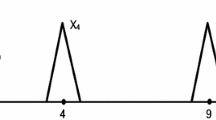Let (pn) be a sequence of nonnegative numbers such that p0 > 0 and
Let (un) be a sequence of fuzzy numbers. The weighted mean of (un) is defined by
It is known that the existence of the limit limun = μ0 implies that limtn = μ0. For the existence of the limit st-limtn = μ0, we require the boundedness of (un) in addition to the existence of the limit limun = μ0. However, in general, the converse of this implication is not true. We establish Tauberian conditions, under which the existence of the limit limun = μ0 follows from the existence of the limit limtn = μ0 or st-limtn = μ0. These Tauberian conditions are satisfied if (un) satisfies the two-sided condition of Hardy type relative to (Pn).
Similar content being viewed by others
References
L. A. Zadeh, “Fuzzy sets,” Inf. Control, 8, 338–353 (1965).
D. Dubois and H. Prade, “Operations on fuzzy numbers,” Internat. J. Systems Sci., 9, No. 6, 613–626 (1978).
R. Goetschel and W. Voxman, “Elementary fuzzy calculus,” Fuzzy Sets Syst., 18, No. 1, 31–43 (1986).
M. Matloka, “Sequences of fuzzy numbers,” Busefal, 28, 28–37 (1986).
S. Nanda, “On sequences of fuzzy numbers,” Fuzzy Sets Syst., 33, No. 1, 123–126 (1989).
B. C. Tripathy, A. Baruah, M. Et, and M. Gungor, “On almost statistical convergence of new type of generalized difference sequence of fuzzy numbers,” Iran. J. Sci. Technol. Trans. A, Sci., 36, No. 2, 147–155 (2012).
I. Çanak, “On the Riesz mean of sequences of fuzzy real numbers,” J. Intel. Fuzzy Syst., 26, No. 6, 2685–2688 (2014).
Z. Önder, S. A. Sezer, and I. Çanak, “A Tauberian theorem for the weighted mean method of summability of sequences of fuzzy numbers,” J. Intel. Fuzzy Syst., 28, No. 3, 1403–1409 (2015).
H. Fast, “Sur la convergence statistique,” Colloq. Math., 2, 241–244 (1951).
I. J. Schoenberg, “The integrability of certain functions and related summability methods,” Amer. Math. Monthly, 66, 361–375 (1959).
A. Zygmund, Trigonometric Series: Vols. I, II, Cambridge Univ. Press, London–New York (1959).
F. Nuray and E. Savaş, “Statistical convergence of sequences of fuzzy numbers,” Math. Slovaca, 45, No. 3, 269–273 (1995).
E. Savaş, “On statistically convergent sequences of fuzzy numbers,” Inform. Sci., 137, 277–282 (2001).
S. Aytar and S. Pehlivan, “Statistical convergence of sequences of fuzzy numbers and sequences of α-cuts,” Int. J. Gen. Syst., 37, No. 2, 231–237 (2008).
F. Başar, Summability Theory and Its Applications, Bentham Books (2012).
J. S. Kwon, “On statistical and p-Cesàro convergence of fuzzy numbers,” Korean J. Comput. Appl. Math., 7, No. 1, 195–203 (2000).
Ö. Talo and F. Başar, “On the slowly decreasing sequences of fuzzy numbers,” Abstr. Appl. Anal., 2013, Article ID 891986 (2013).
Ö. Talo and C. Bal, “On statistical summability \( \left(\overline{N},P\right) \) of sequences of fuzzy numbers,” Filomat, 30, No. 3, 873–884 (2016).
M. Et, B. C. Tripathy, and A. J. Dutta, “On pointwise statistical convergence of order ↵ of sequences of fuzzy mappings,” Kuwait J. Sci., 41, No. 3, 17–30 (2014).
F. Móricz, “Ordinary convergence follows from statistical summability (C, 1) in the case of slowly decreasing or oscillating sequences,” Colloq. Math., 99, No. 2, 207–219 (2004).
F. Móricz, “Theorems relating to statistical harmonic summability and ordinary convergence of slowly decreasing or oscillating sequences,” Analysis (Munich), 24, No. 2, 127–145 (2004).
D. Dubois and H. Prade, “Fuzzy sets and systems,” Mathematics in Science and Engineering, 144, Academic Press, New-York–London (1980).
B. Bede, “Mathematics of fuzzy sets and fuzzy logic,” Studies in Fuzziness and Soft Computing, 295, Springer, Heidelberg (2013).
P. V. Subrahmanyam, “Cesàro summability for fuzzy real numbers,” J. Anal., 7, 159–168 (1999).
G. A. Mikhalin, “Theorems of Tauberian type for (J, pn) summation methods,” Ukr. Math. Zh., 29, No. 6, 763–770 (1977); English translation: Ukr. Math. J., 29, No. 6, 564–569 (1977).
J. Boos, Classical and Modern Methods in Summability, Oxford Univ. Press, Oxford (2000).
Author information
Authors and Affiliations
Corresponding author
Additional information
Published in Ukrains’kyi Matematychnyi Zhurnal, Vol. 73, No. 8, pp. 1085–1101, August, 2021. Ukrainian DOI: 10.37863/umzh.v73i8.584.
Rights and permissions
About this article
Cite this article
Önder, Z., Çanak, İ. Tauberian Conditions Under which Convergence Follows from the Weighted Mean Summability and Its Statistical Extension for Sequences of Fuzzy Numbers. Ukr Math J 73, 1259–1277 (2022). https://doi.org/10.1007/s11253-022-01989-4
Received:
Published:
Issue Date:
DOI: https://doi.org/10.1007/s11253-022-01989-4



